New Work—Mojave Desert Artifacts
I just updated my website with new images from my Mojave Desert Artifacts series. I will be going back into the studio for the next few weeks, and will be uploading more as soon as I can.
I just updated my website with new images from my Mojave Desert Artifacts series. I will be going back into the studio for the next few weeks, and will be uploading more as soon as I can.
 Here is new work from my series of "artifacts" collected from an makeshift gun range in the Mojave Desert.
Here is new work from my series of "artifacts" collected from an makeshift gun range in the Mojave Desert.
I made a cross-country drive a few weeks ago, and was able to bring back crates of these collected objects to my studio near Philadelphia. In addition to photographing more of the new and much larger pieces, I will incorporate the actual objects to be shown alongside the large format platinum prints as kind of a mock-anthropological exhibition based on the culture of the desert southwest.
A large-format platinum print will be on view at Project Basho's Onward 2011 show opening today, with an opening reception on Saturday, Feb, 12. I will be there between 2:30 to 4:30, so stop by to have a chat and see some great photography by emerging artists from around the globe.
 Mojave Desert Artifact #5, 2010
Mojave Desert Artifact #5, 2010I am thrilled to announce that one of my new platinum prints from my Desert Artifact series was selected by Larry Fink for Onward, Project Basho's juried exhibition for emerging photographers. The opening reception is February 12, and the show runs through March 27.
Here is a video or people in Philadelphia announcing the selected photographers.
[youtube=http://www.youtube.com/watch?v=DJ8na4Dz4ME&fs=1&hl=en_US]
(1:16)
These new photographs, 16" platinum-palladium prints made in the summer of 2010, are an extension of the aerial photographs I made of an off-highway recreation area in 2009. I am in the process of writing a more complete statement about the larger scope of the project, but for now, I will say that looking at the culture of recreation in the desert from the point of view of a future archaeologist and historian is an interesting way of exploring my own history within the context of the culture where I grew up, and, at the same time, not pass judgment of the people or the area.

I finally had a chance to develop my films from my June trip out West. I even developed some other films that were sitting in a box for just over a year . . . This from my most recent trip to work on my series on the Lower Owens River Project. This was made near the culverts on the South side of Manzanar Reward Road. I have been mapping some of the images on Google Earth. Here is an image from Google Maps of what the area looked like before water was flowing. View Larger Map
There is something about the space in the West that is rare to touch when making a photograph. I am not altogether sure if this one is successful, but I know when I made this that I was dipping into that peaceful experience of being out in the middle of nowhere, with nothing but creosote, jack rabbits, and rattlesnakes for miles around.
Here is something newish. I was out West at the end of November photographing an area near where I grew up that is battling a Los Angeles Department of Water and Power project that plan to put up eight-some miles of high tension power lines through public and private lands—some of which are designated preserves. I hope to be again in the next few weeks to continue photographing the area.
The problem with trying to use photography to help stop the development in the area is that, even though it is a beautiful and magical landscape, it isn't a spectacular one. It is a subtle landscape, one without majestic peaks, or towering trees, but altogether beautiful in with its open, unblemished space and abundance of life.
In reality, does a run of powerlines really cause lasting harm to the environment? Maybe not, but the devastation would be that which comes next. The power lines would be something like the equivalent of the Broken Window or Ghetto Effect in a city. When the sight of the power lines becomes accepted, it isn't long until the area looks as disgusting as Apple Valley—Yucca Valley, my home town, is long down on its course toward the homogenized and sprawling western town—valuing popular fast food restaurants and frappuccinos over real community, and real culture.
I am offering a special holiday promotion on all 8x10-inch contact prints from my website. This offer will last until the end of the year, and will include a gift of one 8x10-inch silver gelatin contact print when you purchase one at full price ($400 + shipping). This will help offset the cost of materials and future trips to continue photographing the Lower Owens River Project. More information and photographs from the first year of the project can be found on my Website.
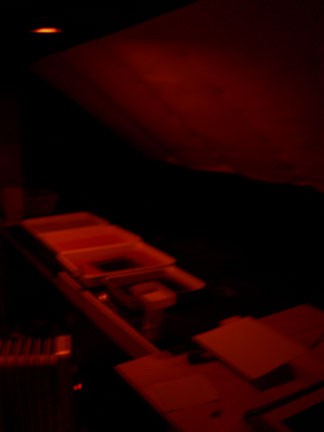
I have needed to build a new darkroom for every house I moved into for the last six or seven years. Some have been nicer than others–with running water and heating/air conditioning—and some have been in nasty, dank basements, or ones so small I needed to do a week of crunches before I could develop my films. Last night, I printed for the first time in my new darkroom I just set up in the attic. It does not have running water, and I have to carry it up a flight of stairs, and commandeer the bath tub to set up the print washer. But, it feels good, and because of that, I feel like I will be more productive than in some of my previous darkrooms.
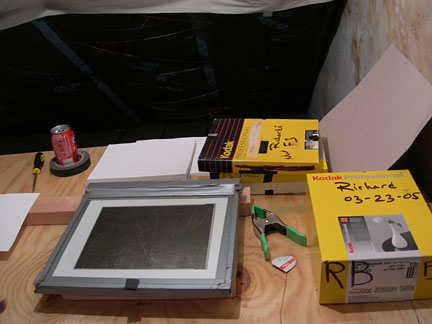
It kindof reminds me of the forts I used to build with friends as a little kid—using sheets, books, the coffee table—whatever was on hand. And that is the kind of the spirit that went into this one. It really made me reconnect with what got me so excited about photography in the first place. Not to sound cliche, but having an image appear on paper with nothing more than light and a few chemicals is sort of magical—even more so now that I am actually making beautiful prints (as apposed to the chalky gray ones my first time around). It also made me remember the reason I started using an 8x10 in the first place—the simplicity of it all.
Here are two of the prints I made last night. Both are from my most recent trip the Owens Valley.

Owens (dry) Lake near the Lower Owens River Project Pumpback Station and Delta Area. It will be interesting to see how this area changes in the next few years. There are no plans to refill the lake, and much if it is levied off for the dust mitigation program. There is, though, a small continuous flow of water to support the delta wildlife habitat area.

In the Lower Owens River Riparian habitat area. Near Lone Pine, California. November, 2007
I finally got around to scanning some of the photographs I made on my trip in September, and a few of the ones I have printed from my most recent trip in November.
Also, I just updated my website with some of these new photographs, as well as added captions with a more specific location for each individual picture (you will have to click to the right of the image where is says "show / hide caption").
I hope to have the remaining negatives printed from this last year by the end of the month, so keep checking back for more updates.
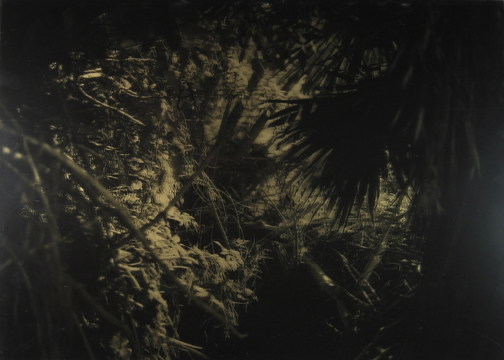
Before flying back to the East Coast on Friday, I had the pleasure of meeting Los Angles photographer, Matthew Betcher, and seeing his exhibition of incredible large-scale orotones from his series el rio de nuestra señora la reina de los angeles de porciuncula. I just learned the show has been extended to the end of the year, and is surely not to be missed.
Inspired by Edward Curtis's Orotones— a process involving ambrotypes backed with gold pigment in banana oil—Betcher printed on orthochromatic lith film that was slightly bleached, toned, then mounted on glass backed with gold leaf.
Along with the show of about ten 40x60-inch pieces, is a beautiful a 19x25-inch portfolio of all the photographs in the series. Again, they are hand-printed lith film, with gold painted rice paper, hand-bound and housed in a box that contains an orotone on the bottom. The book is a work of art in itself.
These three digital images may give one the idea of what the show is about, but nothing can replace the feeling of being in front of these in person. They are almost dream-like in the way details disappear in the three dimensional quality achieved by the interplay of light and the layering of image, glass, and gold leaf.
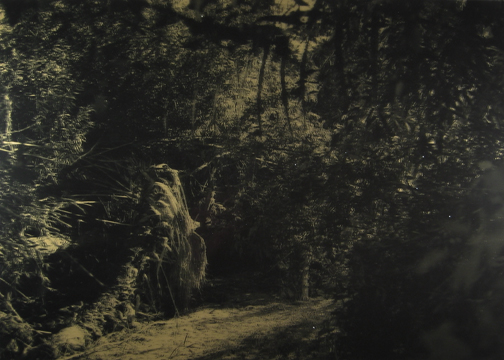
In Matthew's introduction he writes:
For the series, I have been exploring the LA River as a datum for the explorations and questions relating to a new sense of what is ‘nature.’ Knowing the River was originally named after the small field (’porciuncula’ is loosely defined as ‘a small portion of land’) where St. Francis of Assisi developed a monastic order based on a lack of worldly possessions and an admiration for the natural environment, the Los Angeles River becomes a paradox in its own right. The massive concrete structure intended to allow the massive expanse of the city now protects the Glendale Narrows - one of the few spaces in a concrete city choked by its own waste where, as a protected sight, ‘nature’ is left to fend for herself. For the work, I have been using a photographic technique used mainly in the teens that involve photographs on gold-backed glass. The idea is that the large scale gold-leafed plates adorning the jungle-like images from the Los Angeles River bring into question the schizophrenic ideals of what is or could be considered ‘natural.’
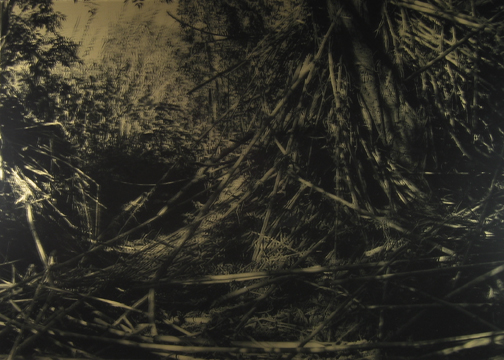
Here, there are no swimming pools, no movie stars, but a mutation of nature that continues to thrive in a place no typical Angelino would go. As a dedicated nature preserve, the Glendale Narrows represents the natural world Los Angels couldn't manicure or pave with concrete. The images are, for me, both a metaphor and the antitheses of the City.
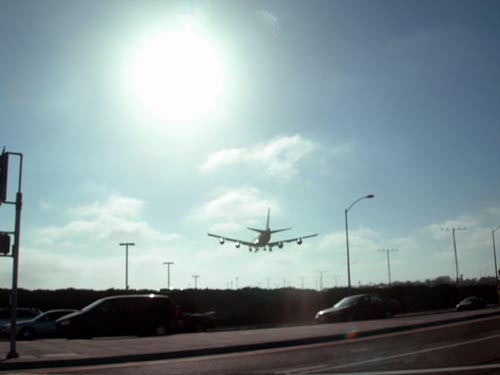
I saw the Edward Weston: Enduring Vision show at the Getty Center today before heading back to the East Coast tonight. The show was good, with a few pictures that I don't believe I have seen before. More about that later.
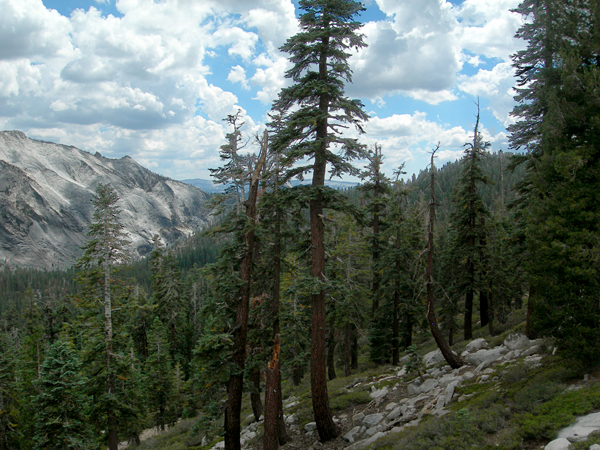
The first time I drove into Yosemite, they handed me a flier about a not leaving food in your car while in the Park. Bears will smell it, and proceed to tear the doors off your car trying to get to the food. So, you could imagine my fear as I sit with my arms stuck in a film changing tent with a stack of 10 holders to change, and thinking about the remnants of a burrito on the front seat. I am not sure if I could effectively scare away a black bear by waving around a funny looking tent. Fortunately, there were no bears, and I continued photographing until the lightning started. For some reason, I am also scared to be photographing with a big metal camera in a lighting storm . . .
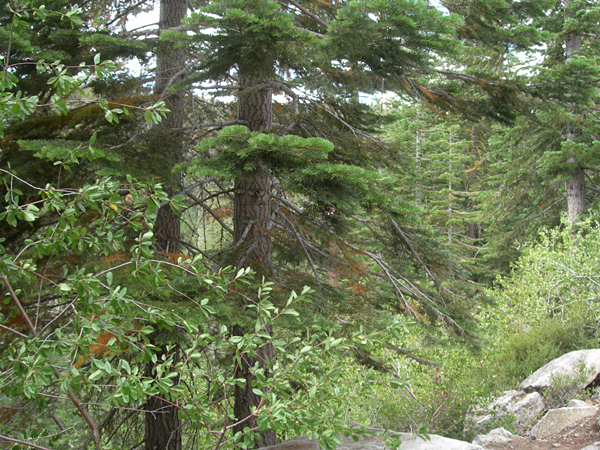
Part of the reason for the lack of posts over the last week was this trip to California. There are always ten million things to do before a trip, and it always seems like the amount of work is multiplied when traveling by air.
I got into the desert late Monday night—just in time to watch a full lunar eclipse. I was thinking, "this either means it is going to be one great trip, or a terrible one."
Before I could do any photographing, I needed to climb on the roof to fix my parents air conditioner to make sure there was a comfortable place to hide out during the worst of the heat. I am not one to complain about the heat—I even enjoy it to a point. Given enough water and burritos, I can work all day in the 90s, but anything over 100 is just swimming weather. I do remember September in the desert being hot, but not unbearably so. According to a highway sign, it was 105 today.
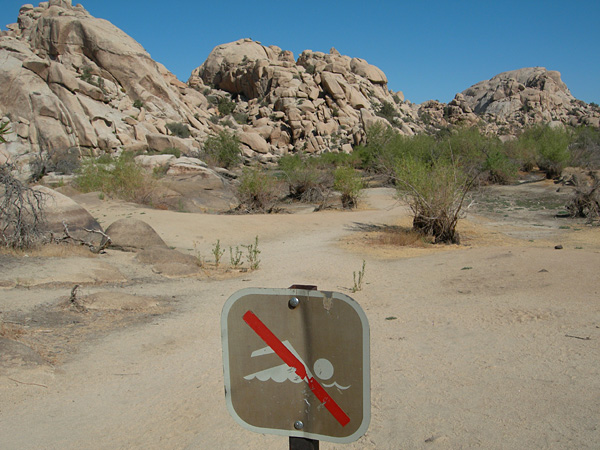
It seems ridiculous to not acknowledge that climate change is real. Just look at the drought in Florida in the Spring, the current heat wave and drought in the Southeast, drought in Australia, Northern Brazil, and, maybe the most extreme example at the moment, Greece. I think, for the most part, we have all agreed that climate change is real, but few people know what the global affects will be, how to reverse, or even stop our course.